Odds are that in the long term those two units are equal. Twice as many MOVs, but MOVs are not precision devices, the lowest trip point MOV will take the full surge until it dies, then the next lowest, then the next lowest, etc.
I can see a situation where, if they both use identical everything except one has more MOVs, the one with more MOVs will last longer.
I can also see a situation where the first MOV to die kills the surge protector (it
should kill it, really. Then it should warn you).
The reality of the situation is that it is pure guesswork, much like if a company makes two CPUs, gives them a MHz rating, then puts them in a box where you cannot see them or plug them in. You don't get any benchmarks, nor do you get anything else to compare them to. You can read the numbers and guess, but you have no real data. It's
The Emperor's Nose, essentially.
Test equipment wise, at the very least you need a capacitor bank of significant size that you can charge to a few thousand volts. I've seen 6000v used as a testing spec, given that voltage you'd need a 50uF bank to store a 900 joule charge.
At a more easily attainable 2000v, you need 500 uF for a 1000 joule charge.
The next thing on my list as far as this operation goes is cracking open a few CRTs to see what their HV caps are rated at. (Don't do this, it's even more dangerous than cracking PSUs open, monitors can store a charge for years)
If they're rated high enough / large enough I may be able to build a basic tester for less than the kilobuck they cost to buy. If you touch the output of this bank, you will die.
Beyond the capacitor bank you need a way to charge the caps to however many thousand volts (and not over!), this is arguably the easiest part if you don't mind a long charge time. If you want to do multiple surges in quick succession it gets more expensive/complicated.
Beyond that you need a HV / high amp switch to dump the energy into the poor unfortunate surge protector. The switch needs to be able to survive a few thousand amps, though not for very long. A simple mechanical job switched with a long plastic stick is probably the way to go. Just replace it when it has melted beyond usefulness.
Then you need something plugged in, a light bulb would be fine.
Once you have all that, you'll need a digital scope to track the output of said surge protector, this part you won't be making yourself. It'll run at least $100 for a basic unit.
Ideally you'd have a 120VAC sine wave on the thing that you're overlaying your DC surge on, good luck with that though. How important this is I don't know. From a purely surge suppression standpoint probably not very. From a fire standpoint, it may be more important.
Testing is fatal to surge protectors, or at the very least you can no longer trust them. They're good for one (1) surge for sure. After that it depends on how big the surge was and how much damage it did to the MOV(s). The damage done ranges from none on the low end to grenading with fire on the high end.

 (I am not in the US by the way)
(I am not in the US by the way)

